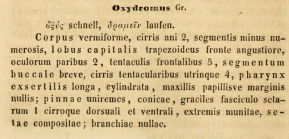RAS taxon details
Oxydromus Grube, 1855
173457 (urn:lsid:marinespecies.org:taxname:173457)
accepted
Genus
Ophiodromus Sars, 1862 · unaccepted (subjective synonym)
Orseis Ehlers, 1864 · unaccepted (subjective synonym)
- Species Oxydromus incomptus (Ehlers, 1913) accepted as Gyptis incompta Ehlers, 1913 (superseded subsequent combination)
marine, brackish, fresh, terrestrial
recent only
masculine
Grube, Adolph Eduard. (1855). Beschreibungen neuer oder wenig bekannter Anneliden. <em>Archiv für Naturgeschichte, Berlin.</em> 21(1): 81-136, plates III-V., available online at https://biodiversitylibrary.org/page/6651100
page(s): 98 [details]
page(s): 98 [details]
Read, G.; Fauchald, K. (Ed.) (2025). World Polychaeta Database. Oxydromus Grube, 1855. Accessed through: RAS (Eds.) (2025) Register of Antarctic Species at: https://ras.biodiversity.aq/aphia.php/www.pfeil-verlag.de/04biol/rest/aphia.php?p=taxdetails&id=173457 on 2025-09-12
RAS (Eds.) (2025). Register of Antarctic Species. Oxydromus Grube, 1855. Accessed at: https://ras.biodiversity.aq/aphia.php/www.pfeil-verlag.de/04biol/www.pfeil-verlag.de/04biol/aphia.php?p=taxdetails&id=173457 on 2025-09-12
Date
action
by
original description
Grube, Adolph Eduard. (1855). Beschreibungen neuer oder wenig bekannter Anneliden. <em>Archiv für Naturgeschichte, Berlin.</em> 21(1): 81-136, plates III-V., available online at https://biodiversitylibrary.org/page/6651100
page(s): 98 [details]
original description (of Orseis Ehlers, 1864) Ehlers, E. H. (1864). Die Borstenwürmer (Annelida Chaetopoda) nach systematischen und anatomischen Untersuchungen dargestellt. , available online at https://www.biodiversitylibrary.org/page/1985759
page(s): 188 [details]
original description (of Ophiodromus Sars, 1862) Sars, M. (1862). Uddrag af en af detaillerede Afbildninger ledsaget udf rlig Beskrivelse over f lgende norske Annelider. Forhandlinger fra Videnskabs-Selskabet i Christiania, 1861: 87-95., available online at https://www.biodiversitylibrary.org/page/60512056
page(s): 87 [details]
status source Villalobos-Guerrero, Tulio; Harris, Leslie. 2012. Oxydromus Grube, 1855 reinstated over Ophiodromus Sars, 1862 (Polychaeta, Hesionidae). ZooKeys 241(0): 21-31, available online at https://doi.org/10.3897/zookeys.241.3820 [details]
ecology source Britayev, Temir A.; Antokhina, T.I. (2012). Symbiotic polychaetes from Nhatrang Bay, Vietnam. In: Britayev, T.A.; Pavlov, D.S. (eds). <em>[book].</em> Benthic fauna of the Bay of Nhatrang, Southern Vietnam. Moscow: KMK Scientific Press. 491 pp. Volume 2: 11-55., available online at https://www.researchgate.net/publication/258626701_Symbiotic_polychaetes_from_Nhatrang_Bay_Vietnam
page(s): 30 [details] Available for editors
identification resource Rizzo, A. E.; Salazar-vallejo, S. I. (2014). Hesionidae Grube, 1850 (Annelida: Polychaeta) from South-Southeastern Brazil, with descriptions of four new species. Zootaxa. 3856(2): 267-291., available online at https://doi.org/10.11646/zootaxa.3856.2.7
page(s): 281 [key to genus Oxydromus] [details]
page(s): 98 [details]
original description (of Orseis Ehlers, 1864) Ehlers, E. H. (1864). Die Borstenwürmer (Annelida Chaetopoda) nach systematischen und anatomischen Untersuchungen dargestellt. , available online at https://www.biodiversitylibrary.org/page/1985759
page(s): 188 [details]
original description (of Ophiodromus Sars, 1862) Sars, M. (1862). Uddrag af en af detaillerede Afbildninger ledsaget udf rlig Beskrivelse over f lgende norske Annelider. Forhandlinger fra Videnskabs-Selskabet i Christiania, 1861: 87-95., available online at https://www.biodiversitylibrary.org/page/60512056
page(s): 87 [details]
status source Villalobos-Guerrero, Tulio; Harris, Leslie. 2012. Oxydromus Grube, 1855 reinstated over Ophiodromus Sars, 1862 (Polychaeta, Hesionidae). ZooKeys 241(0): 21-31, available online at https://doi.org/10.3897/zookeys.241.3820 [details]
ecology source Britayev, Temir A.; Antokhina, T.I. (2012). Symbiotic polychaetes from Nhatrang Bay, Vietnam. In: Britayev, T.A.; Pavlov, D.S. (eds). <em>[book].</em> Benthic fauna of the Bay of Nhatrang, Southern Vietnam. Moscow: KMK Scientific Press. 491 pp. Volume 2: 11-55., available online at https://www.researchgate.net/publication/258626701_Symbiotic_polychaetes_from_Nhatrang_Bay_Vietnam
page(s): 30 [details] Available for editors
identification resource Rizzo, A. E.; Salazar-vallejo, S. I. (2014). Hesionidae Grube, 1850 (Annelida: Polychaeta) from South-Southeastern Brazil, with descriptions of four new species. Zootaxa. 3856(2): 267-291., available online at https://doi.org/10.11646/zootaxa.3856.2.7
page(s): 281 [key to genus Oxydromus] [details]
 Present
Present  Inaccurate
Inaccurate  Introduced: alien
Introduced: alien  Containing type locality
Containing type locality
